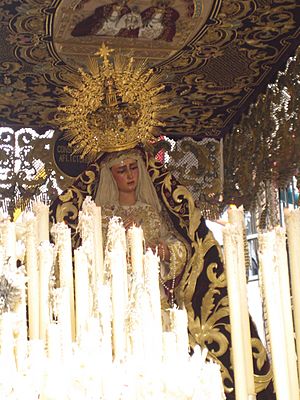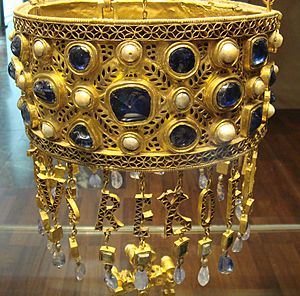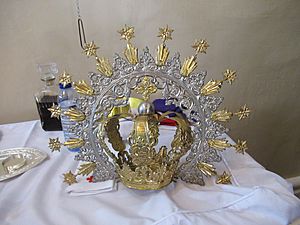Votive crown facts for kids
A votive crown is a special kind of crown given as a gift to a god or a saint. People offered these crowns to show thanks or to ask for something. They were often made from valuable metals like gold and decorated with shiny jewels.
In the past, especially during the Early Middle Ages, many votive crowns were made to hang from chains. They would be placed above an altar, a holy place, or a statue. Later on, some regular crowns were also used as votive offerings, placed on statues of saints or important figures.
Contents
Ancient Crowns: Gifts to the Gods
Long ago, even before Christianity, people offered crowns to their gods. We know about these from old stories. For example, a famous Greek thinker named Archimedes helped a king named Hiero II of Syracuse. The king had given gold to a goldsmith to make a votive crown for a temple statue. But the king thought the goldsmith might have cheated him by mixing in cheaper metal.
Archimedes figured out how to test the crown. He put the crown in water and measured how much water it moved. Then he did the same with pure gold of the same weight. This helped him discover if the crown was truly pure gold. It turned out the goldsmith had added silver!
People in ancient times also gave crowns to living rulers. They hoped the rulers would be kind to them or grant their wishes.
Hanging Crowns: Gifts for God
Many of the oldest Christian hanging votive crowns that still exist are from the 600s. They come from a part of Spain ruled by the Visigoths. The most famous collection is the Treasure of Guarrazar, found near Toledo. This treasure includes 26 gold crowns! They were probably hidden when a Muslim army was about to invade.
These crowns were found in 1859. Today, some are in a museum in Madrid, Spain, and others are in Paris, France. This style of hanging crown first came from the Roman or Byzantine empires. It was used all over Europe. Sadly, most of these old crowns were lost because they were valuable and easy to steal.
These hanging crowns were not meant to be worn. They were often too small. Many had small, dangling ornaments called pendilia. These ornaments often had jewels or even spelled out words. For example, on one crown, the pendilia spell "RECCESVINTHVS REX OFFERET." This means "King Recceswinth offered this."
When kings gave these crowns, it showed that they respected God's power. This idea might have come from the 30 gold crowns that Emperor Justinian hung around the main altar of a famous church called Hagia Sophia. Those crowns are now lost.
The main part of these hanging crowns was usually flat on the top and bottom. Some were just open frames made of metal pieces linked together. The Iron Crown of Lombardy was likely first made as a votive crown. But later, it was used to crown kings, including Charles V and Napoleon I.
There's a story about another Byzantine crown. Emperor Maurice (who ruled from 582-602) received a beautiful crown from his wife and mother-in-law. They wanted him to wear it for Easter. But instead, he hung it over the main altar of Hagia Sophia. This made the two ladies very upset! The crown stayed there for almost 200 years. Then, Emperor Leo IV took it for himself. Soon after, he became very sick and died. Many people in the church believed it was a punishment for taking the crown.
Crowns for Statues

In England, a story says that King Canute gave his crown to be placed on a large crucifix in Winchester Cathedral. Other important people decorated statues with their jewelry or even swords. In 1070, some men stole a solid gold crown from a crucifix in Peterborough Cathedral.
During the Romanesque period, many statues of Christ showed him wearing a crown on the cross. This was common in wooden and metal figures, and in old books with pictures. This time also saw the first crowned statues of the Virgin Mary in the West. This happened as the idea of Mary as the "Queen of Heaven" became more popular.
A very small crown in Aachen Cathedral was made for a fancy wedding in 1468. It belonged to Margaret of York, the sister of an English king. Later, it was placed on a statue of the Virgin Mary as a gift. This crown was designed to be worn over a fancy hairstyle or hat. It is much smaller than a normal crown worn directly on the head. This crown is a rare example of a medieval votive crown that still exists today.
Crowns made just for statues became more detailed over time, especially during the Baroque period. This was very true in Spanish-speaking countries. These crowns often have a flat, ray-like "sunburst" design around them. This is similar to the design used for special containers called monstrances. Statues of the Virgin Mary and the Infant Jesus (like the Infant Jesus of Prague) are often crowned.
The Crown of the Andes is a famous votive crown from Colombia. It is made of gold and has 450 emeralds! It was likely made between the late 1500s and 1700s. It might have been a thank-you gift because the city of Popayán was saved from a terrible sickness. Today, this crown is owned by a private collector in the United States.
Modern Votive Crowns
Votive crowns are still made in Catholic countries today. Often, these crowns are kept safely in the church treasury. They are only put on the statues for special occasions, like certain holy days.
In Christian art, Jesus and the Virgin Mary are often shown wearing crowns. This is common in pictures like the "Coronation of the Virgin" (where Mary is crowned Queen of Heaven). They are the most common figures to receive crowns. But other saints can also be given crowns, especially if they were kings or queens, or if they were martyrs (people who died for their faith). Many religious texts say that martyrs will receive crowns in heaven.
In Greece, a small gift called a tama can be given. If it shows two tiny wedding crowns, it means someone is asking for a happy marriage. The actual crowns used in a wedding ceremony are usually kept by the married couple.
See also
 In Spanish: Corona votiva para niños
In Spanish: Corona votiva para niños




